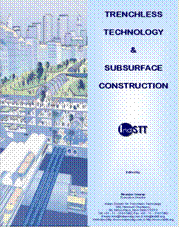|
|
Preface
Constructing under the surface or subsurface construction is what the Trenchless Technology Techniques are all about. In order to enhance the quality of life without spoiling the environment, optimum use of Underground Spaces is natural and therefore the importance of Trenchless Technology.
Definition wise Trenchless refers to a situation where one is talking about fewer trenches while executing subsurface works. In other words one is working below the ground surface without exposing the complete network.
Subsurface construction activities not only cover new developmental activities but also address the requirements of subsurface network rehabilitation as well replacements.
Any construction professional engaged in the hands-on works will always need to develop the basic understanding about what lies beneath and the skills to develop subsurface solutions in such a way that the new one can coexist with the existing without destroying them or the environment.
Subsurface Utility Managers (SUM) is one of HRD initiative of Indian Society for Trenchless Technology. It comprises of five programs. The first module titled Awareness of Subsurface & Trenchless Technology (SSTT) is aimed at providing brief information of the subject to the Construction professionals.
This module has eleven sections as dealt in this guideline book. Intent of this guideline is to provide the user/reader an orientation in Trenchless Technology sector. Through this guideline it is aimed to present a brief outlook about importance of the underground space, need and utility of Subsurface (underground) Construction, Various methods of construction and their merits and demerits, and finally the different trenchless techniques.
Expected outcome of these guidelines is the development of a better understanding of underground conditions and respective family of Trenchless Techniques in the reader / Module participant so that he is able to identify the appropriate trenchless methods for a given set of project requirements.
For example, if the constructor is aware of the subsurface conditions and the appropriateness of various trenchless techniques, he or she can prepare his work-plan meeting such site requirements and conditions. The optimization is best achieved with selection of appropriate equipment and method. Further many times a minor adjustment makes a specific method appropriate for the underground conditions that will be encountered in a project. This module as well as the subsequent stages will provide the insight to some of these special adjustments, so the utility worker can maximize the use of specific equipment for a range of project conditions.
Next modules of this group deal with the trenchless techniques related to Asset Creation, Asset Rehabilitation, & Asset Termination of subsurface civic infrastructure networks. Further in order to provide information about methods of subsurface investigations, one module on Subsurface Utility Engineering is included to complete this program of SUMs.
These guidelines should serve as an aid for the underground utility owner and / or designer by providing background information regarding trenchless construction equipment and/or methods and underground condition compatibility. It is explicitly explained that these modules are developed and the guidelines are provided in good faith. Users are advised to exercise utmost care in using these guidelines as they are meant to provide the introductory information only and these should not replace the project designs and sound engineering selection processes.
Dr. Niranjan Swarup Director General Indian Society for Trenchless Technology
Chapter 1
Chapter 2
Chapter 3
Chapter 4
Chapter 5
Chapter 6
Chapter 7
Chapter 8
Chapter 9
Chapter 10
Chapter 11 Benefits, Economics, Social Impacts,
Glossary.................................................................................................................. 259 ~ 286
Reference............................................................................................................... 287 ~ 287
|

 Underground space
is vital for the functioning of our modern society. This is where the
arteries of our cities and communities are located – with pipelines for
utilities and waste disposal, cables and communication networks, and
underground transport routes. And the underground space has still more
potential to offer. Shifting production facilities, cultural and service
centres into the underground space can make room for an ecologically
intact environment at the surface.
Underground space
is vital for the functioning of our modern society. This is where the
arteries of our cities and communities are located – with pipelines for
utilities and waste disposal, cables and communication networks, and
underground transport routes. And the underground space has still more
potential to offer. Shifting production facilities, cultural and service
centres into the underground space can make room for an ecologically
intact environment at the surface.